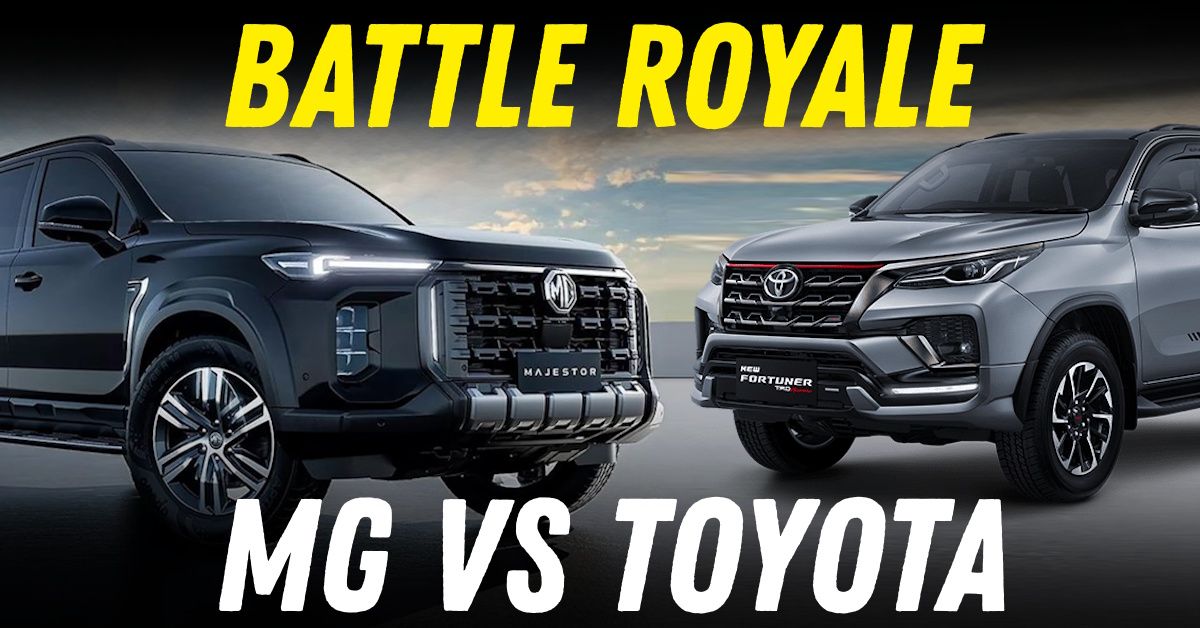MG Majestor Launching Next Month: Can Its Tech and Value Topple the Toyota Fortuner?


For over a decade, the Toyota Fortuner has ruled India’s premium SUV segment like a monarch. Priced above ₹50 lakh for its top variant, it continues to command loyalty with its solid build, commanding road presence, and time-tested diesel powertrain. But a serious new challenger has arrived—MG Motor India’s Majestor, a feature-packed, seven-seater SUV set to launch next month. The question is, can smart technology, modern design, and aggressive pricing shake the Fortuner’s throne?
The Fortuner is more than just an SUV; for many, it’s a symbol of success and reliability. Its proven 2.8-litre diesel engine, proper 4x4 drivetrain, and rugged ladder-frame chassis have made it a go-to choice for buyers who value durability. However, in a rapidly evolving market, the Fortuner’s ageing interiors, minimal tech, and conservative design are starting to show their limitations.
Despite this, demand hasn’t wavered. Buyers continue to fork out upwards of ₹51 lakh for the top-end variant, driven more by trust and image than features. And that’s exactly what MG hopes to challenge.
The MG Majestor is the brand’s most ambitious SUV yet. Based on the Maxus D90 platform and positioned above the Gloster, it combines imposing proportions with contemporary design elements. The front is dominated by a large, gloss-black grille flanked by vertically stacked LED headlamps and sleek daytime running lights. Rugged black cladding, dual-tone 19-inch alloy wheels, chrome roof rails, and connected LED tail-lamps all add to its upscale presence.
Inside, MG has taken a tech-centric approach. Spy shots suggest a freestanding 12.3-inch touchscreen infotainment system and a fully digital driver display. Ambient lighting, black leatherette upholstery with contrast stitching, and a panoramic sunroof elevate the cabin’s luxury quotient. And unlike the Gloster, the Majestor is pitched not just as a powerful SUV, but as MG’s flagship experience—a showcase of everything the brand has to offer.
In contrast to the Fortuner’s functional but dated cabin, the Majestor leans into comfort and gadgetry. While final specs are yet to be confirmed, here’s what we know (or strongly expect):
• Ventilated front seats – still a rarity in this segment
• Panoramic sunroof – absent in the Fortuner
• 12-speaker JBL audio system – compared to Fortuner’s 9 speakers
• Level 2 ADAS features – including adaptive cruise control and lane-keeping assist, which the Fortuner skips entirely
MG seems to be targeting the urban, tech-savvy buyer who expects more than just ruggedness in their SUV.
The Majestor is powered by a 2.0-litre twin-turbo diesel engine producing 218hp and 480Nm of torque. While the Fortuner’s larger 2.8L unit delivers slightly more torque (500Nm), MG’s engine has more horsepower and is paired with an 8-speed automatic gearbox (compared to Toyota’s 6-speed unit). This could translate to smoother shifts and better highway mileage.
Like the Gloster, the Majestor is expected to offer a competent 4x4 system capable of handling rough terrain, though it may not have the same reputation for indestructibility that the Fortuner enjoys.
If there’s one area where MG could swing the battle, it’s pricing. While the Fortuner starts at ₹33.4 lakh, its popular 4x4 diesel automatic variant crosses ₹51 lakh on-road. The Majestor, in contrast, is expected to start around ₹40 lakh (ex-showroom). If MG keeps the top variant well below the ₹50-lakh mark, it could offer better value—especially for buyers comparing 4x4 diesel automatics directly.
A ₹5-7 lakh difference might not make loyal Fortuner fans jump ship immediately, but it’s certainly enough to get new buyers thinking twice.
MG is no longer the outsider it once was. The Hector’s success gave it a foothold, and the Gloster has shown the brand’s intent to stay in the premium segment. With the Majestor, MG seems to be betting on three big shifts in buyer behaviour:
• Tech-first mindset: Younger buyers are more drawn to ADAS features and touchscreen interfaces than off-road heritage.
• Diesel downsizing: As emissions norms tighten, a smaller, more efficient diesel engine might future-proof the Majestor better than the Fortuner’s 2.8L.
• Brand familiarity: MG’s growing network and Gloster’s reliability in India could ease concerns about the Majestor’s long-term ownership.
That said, MG faces significant hurdles. Toyota’s extensive service network (over 350 touchpoints versus MG’s 150), better resale value, and a deeply loyal customer base give the Fortuner an edge that can’t be erased with just features. There’s also the perception factor—the Majestor’s monocoque-style chassis might not win over traditional SUV purists who still prefer a ladder-frame build for that “tough” feel.
The Majestor doesn’t need to replace the Fortuner—it just needs to offer an enticing alternative. If MG prices it right (starting under ₹40 lakh) and backs it with a strong service promise, it could nibble away at 15–20% of the Fortuner’s market share. That would be a significant win in itself.
Ultimately, two things will determine the Majestor’s fate: after-sales service experience and public perception. If MG can convince buyers that the Majestor is not just a Gloster in fancier clothes but a genuine upgrade with substance, this SUV war could get far more interesting.
Put succinctly, the Fortuner is a habit. The Majestor needs to become a craving.